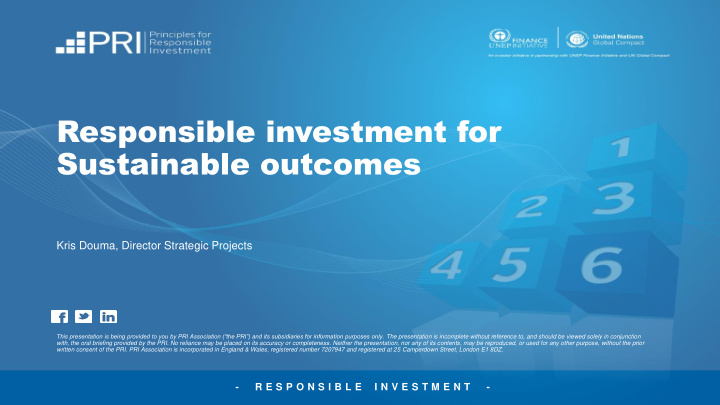



Responsible investment for Sustainable outcomes Kris Douma, Director Strategic Projects This presentation is being provided to you by PRI Association (“the PRI”) and its subsidiaries for information purposes only. The presentation is incomplete without reference to, and should be viewed solely in conjunction with, the oral briefing provided by the PRI. No reliance may be placed on its accuracy or completeness. Neither the presentation, nor any of its contents, may be reproduced, or used for any other purpose, without the prior written consent of the PRI. PRI Association is incorporated in England & Wales, registered number 7207947 and registered at 25 Camperdown Street, London E1 8DZ. - R E S P O N S I B L E I N V E S T M E N T -
The UN Principles for Responsible Investment (PRI) Investor-led, supported by the United Nations since 2006 "We believe that an economically efficient, sustainable global financial system is a necessity for long-term value creation. Such a system will reward long-term, responsible investment and benefit the environment and society as a whole.” 2 2400+ 86+ 2
Enabling Real-World Impact aligned with the SDGs: The SDG Investment Case (PRI/PWC 2017) Why should investors consider SDGs as ‘investment relevant’? SDGs and Fiduciary Duty: asset owners acting in the ultimate interest of beneficiaries Macro Micro Risks Failing to achieve the SDGs will create SDGs provide a future looking risk framework for macro financial risks for large institutional specific industries, companies, geographies and investors, considered to be ‘universal countries owners’. Opportunities Achieving the SDG’s will be a key driver of Companies globally moving towards more global GDP growth over the next 15 years sustainable business practices, products and (towards 2030). services, provide clear investment opportunities. Investors will have an interest to position themselves ‘ahead of the curve’.
The PRI journey to “real - world impact aligned with the SDGs” From 2- dimensional ‘outside - in’ with ESG .. to … 3 - dimensional ‘inside - out’ with SDGs Rationale for RI ESG: outside – in ESG Methodologies SDG: inside – out SDG Methodologies (risk-return) (risk-return and real-world impact) Values Avoid exposure, * norms based Contribute to real- * adapt (strategic) asset allocation process to do no harm screening world impact sustainability objectives * negative screening aligned with SDGs * restructure portfolios to improve SDG contribution * engagement led * active ownership for SDGs divestment * direct investment (thematic, impact, SDGs etc.) Improve Risk Financial * integration Outcomes to society * sustainability (the SDG agenda) provides Return Profile materiality * ESG tilts are unintended investment opportunities * alternative beta/factor investing * engagement Outcome to Unintended: * best in class Intentional * adapt (strategic) asset allocation process to society assumption RI * thematic investing contribution to real- sustainability objectives aligns investors * engagement world impact * restructure portfolios to improve SDG contribution with broader aligned with SDGs * active ownership for SDGs objectives of * direct investment (thematic, impact, SDGs etc.) society 4
From ‘process based’ reporting to ‘outcome based’ reporting (with SDGs) For both enterprises and investors! Increasingly investors will (1) make investment decisions based on the contribution enterprises are making to society and (2) report to their clients/beneficiaries, about their own contribution to society (sustainability, SDGs). To be able to do that, enterprises will have to report on their outcome to society (impact). Impact Management Project (UNDP, UNGC, UNEP-FI, WBSCD, IFC, GRI, SASB, GIIN, PRI a.o.) identify 5 dimensions of impact: What tells us what outcomes the enterprise is contributing to and how important the outcomes are to stakeholders. Who tells us which stakeholders are experiencing the outcome and how underserved they were prior to the enterprise’s effect. How Much tells us how many stakeholders experienced the outcome, what degree of change they experienced, and how long they experienced the outcome for. Contribution tells us whether an enterprise’s and/or investor’s efforts resulted in outcomes that were likely better than what would have occurred otherwise. Risk tells us the likelihood that impact will be different than expected (note: also in other areas). Step 1: ‘outcome based’ thinking needs to be ‘part of the process’, the ‘management system’ (statement of purpose, strategy, policies, implementation, measurement, monitoring, feedback): reporting on processes Step 2: transparency about contribution to society: IMP = work in progress, to facilitate reporting on outcomes . 5
Recommend
More recommend